
If you go down to the zoo today you’re in for a big surprise! Marwell Zoo that is, or more precisely, the adjacent Marwell Hotel where Phil Yeomans is cooking. During our visit, Phil Yeomans emerged from the kitchen looking a young 36 years. The hard work, long hours and stress had not carved his face with premature age lines. After a particularly active summer with busy services in the restaurant and an average of two weddings a week, one might expect him to look drained and exhausted. Instead he exudes a healthy glow, masking his enthusiasm under a self-effacing, mild mannered and softly spoken persona.
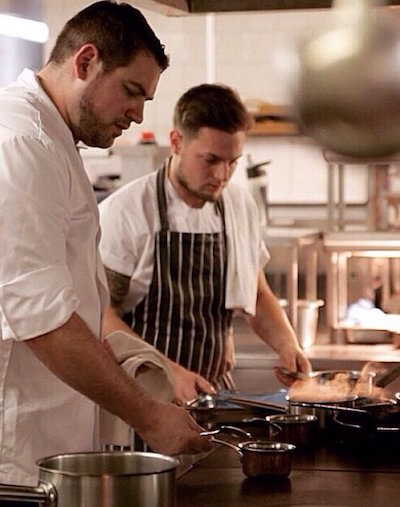 As our conversation progressed, it became clear that the freedom as Executive Chef had reignited his passion for food. Time off before starting at Marwell also allowed him to spend more time with his family, giving a work-life balance so rarely encountered in this pressurised industry. Phil’s impressive CV includes experience in some of London’s top kitchens, spells in the USA and Bermuda, and eight years at Lainston House where his food achieved critical acclaim, including three AA rosettes and 5/10 in the Good Food Guide.
As our conversation progressed, it became clear that the freedom as Executive Chef had reignited his passion for food. Time off before starting at Marwell also allowed him to spend more time with his family, giving a work-life balance so rarely encountered in this pressurised industry. Phil’s impressive CV includes experience in some of London’s top kitchens, spells in the USA and Bermuda, and eight years at Lainston House where his food achieved critical acclaim, including three AA rosettes and 5/10 in the Good Food Guide.
In 2014 Phil accepted an offer he couldn’t refuse from the Bastion Brothers, owners of Marwell Hotel. As Executive Chef, his brief was to transform the Zavanna dining room from one serving adequate but unexciting food, eaten in somewhat soulless, functional surroundings, and delivered with perfunctory service into a fine dining restaurant staffed by a strong brigade in the kitchen and a more professional front of house team.
Such an ambitious project, with huge potential, has been challenging but highly rewarding. Progress was ahead of schedule so that within his first year the kitchen has been redesigned – always a chef’s dream and an essential prerequisite for gastronomic success. This also enabled Phil to offer a tasting menu beyond the normal three course carte. A team of ten chefs, including two colleagues who followed him to Marwell, has been established.
As Phil says, “Unusually, the back of the house has been done before the front of the house.” The arrival of a good pastry chef will enhance that part of the offering, whilst he is able to train his mainly young team to master the basic skills which can be so lacking amongst aspiring chefs joining the profession – before progressing to more demanding techniques.
With major investment at every stage of the process, including refurbishment in some of the hotel’s rooms, it is hoped to launch a new look dining room, with its high pitched roof, by Easter 2016.
Phil appreciates the importance of building a strong front of house team, capable of liaising effectively with both kitchen and diners. This is his next priority. The downfall of many otherwise good restaurants, diners are more likely not to return if they suffer poor service than disappointing food. On the gastronomic front, Phil deserves more exposure, although he prefers to wait until the project is complete before inviting full media coverage.
Nevertheless, his cooking has already been well received and is certainly attracting much local attention, with the restaurant averaging 50-60 covers mid-week and 70 at weekends. One important reason for this is its lack of pretension. Although elements of experimental/molecular technique are evident, these are now used in moderation and where used are integral to the success of the dish rather than mere garnishes. Many dishes are now stripped back, employing classical techniques to maximise clarity of flavour and balance of texture. The apparent simplicity of dishes, making them more accessible to the diner, belies the creativity, flair and technical skill in their conception and execution. Happily, the presentation still features clean lines with a conscious sense of artistry.
The menu, which changes frequently, uses local ingredients wherever possible, sourced from the same suppliers he used previously. As a leading member of Hampshire Food Fair and Farmers’ Market – the largest in England – Phil is passionate about the sourcing of high quality regional produce. Dishes might include ingredients like squid and rabbit, commonly used in the capital but seen less frequently elsewhere. Here is a modest attempt to expand the conservative tastes of some of his provincial diners.
Fundamentally however, his aim is to “offer simple, good value food at a good price” in relaxed and unintimidating surroundings. Whilst this underplays the complexity of his dishes, his success in attracting custom is clearly evident.
The very fair pricing is another bonus. The carte, offering a choice of five starters, mains and desserts is £24.50 for two courses, £32 for three, whilst the five course Tasting Menu (seven including amuse and pre dessert) is £49 or £76 with matching wines. At these prices, it is not surprising that a strong local following, enjoying a standard of cooking that competes easily with many Michelin starred establishments, has developed.
Whilst Phil does not cook primarily for the guides, he aims to achieve at least three AA rosettes to match those he gained at Lainston Country House hotel. Ultimately, he hopes the increased popularity of his cooking will enable the restaurant to stand alone in its own right. Not that the restaurant is the only place where his cooking can be sampled. The stylish Zanzibar lounge offers a good choice bar menu of freshly cooked dishes that attracts families and those who prefer a lighter meal.
Given the embarrassment of choice – I wanted to try everything – I opted for the tasting menu, which includes dishes from the carte. The multi component ingredients are understated, allowing for a surprise element revealed as they are presented.
The mini white, brown and fennel loaves, fresh from the oven, immediately created a good impression with their yeasty aroma, crisp crusts and delicate crumb.
An ethereally light amuse bouche of shitake, artichoke espuma, black olive and parmesan was a happy marriage of subtle and strong flavours which served its purpose of exciting the palate.
The first course of seared scallops was accurately timed to produce a caramelised crust and succulent flesh. The surprise ingredient and a real revelation was the oyster leaf, which, far from being decorative, gave the dish another dimension, as if eating a whole ozone infused oyster. A light crab bisque added a rich crustacean flavour without being overpowering whilst sauvignon poached pear gave a contrasting sweetness. Lemon pearls – one of the few molecular elements on the whole menu and here used to good effect – provided the acidity the dish needed. (Wine: Bola prosecco Conegliano-Valdobbiadene DOC)
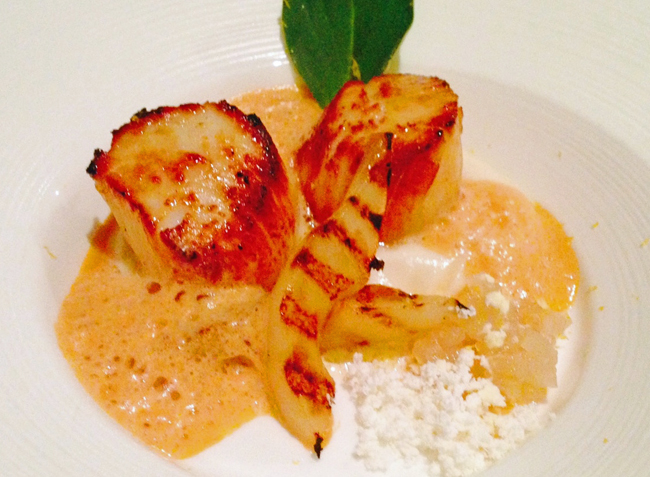
A well flavoured and accurately seasoned terrine of rabbit came next, the meat retaining its moist texture and delicate flavour. Offset by a quenelle of not over sweet Mirabelle plum chutney and dressed with frisse salad, shimeji mushrooms and a scattering of crushed hazelnuts, this was well balanced, classically based dish. (Wine: Friulano, Grave del Friuli, Borgo Tesis, Fantinel)
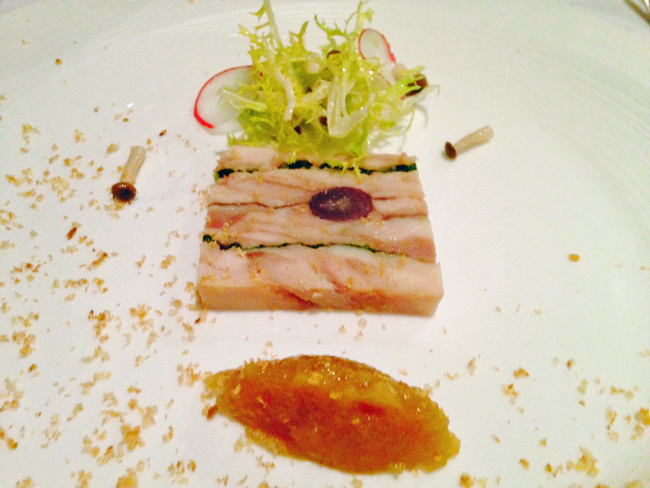
The lightly crusted, thick plaice fillet was perfectly cooked to enhance its lively flavour. It worked well with the accompaniments of braised aubergine, mussels and squid ink farfalle, giving a Mediterranean – Middle Eastern twist, emphasised by a judicious, surprise addition of harissa which lifted the whole dish. Crisp baby broccoli added freshness, colour and texture. (Wine: Sancerre, La Graveliere, Joseph Mellot)
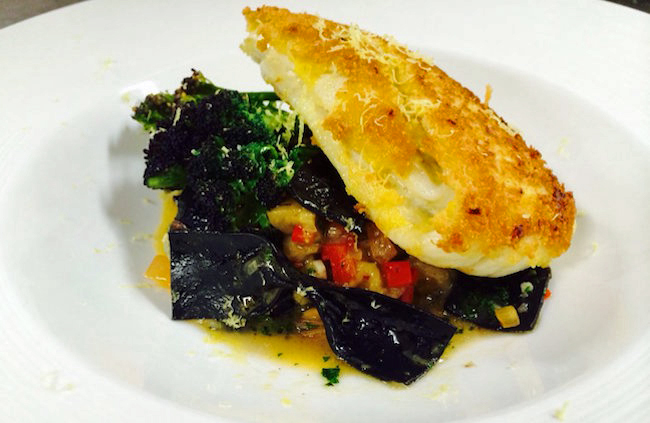
Lamb rump was cooked to a blushing pink, doing full justice to the cut, whereas the shoulder meat benefitted from long, slow cooking. Classic accompaniments included a smooth garlic confit and a tranche of boulangere potatoes. (There might have been more of this as it was so delicious!) The surprise element which really raised this dish to lofty heights was the gremolata, giving a herby, lemony punch to balance the sweet meat. (Wine: Portillo Malbec, Bodegas Salentein, Mendoza)
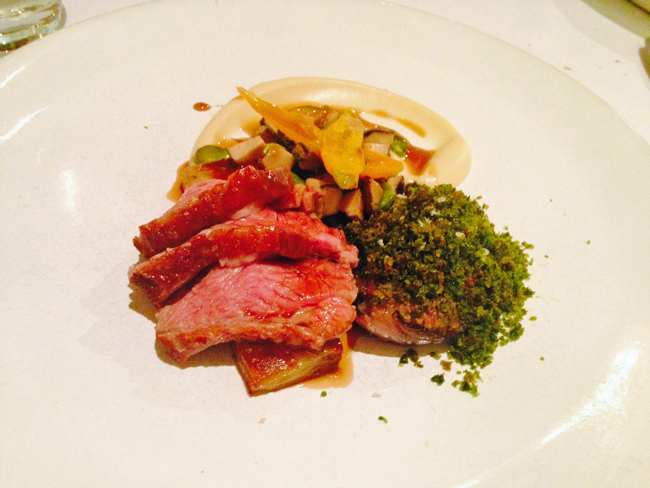
A tropically themed pre dessert featured tangy passion fruit curd, refreshing pineapple sorbet of velvety consistency, guava espuma and crumble for contrasting texture. This on its own in a larger portion would have made a pleasurable course in its own right – I could have eaten a bowlful – but it was a mere prelude for the riches to come.
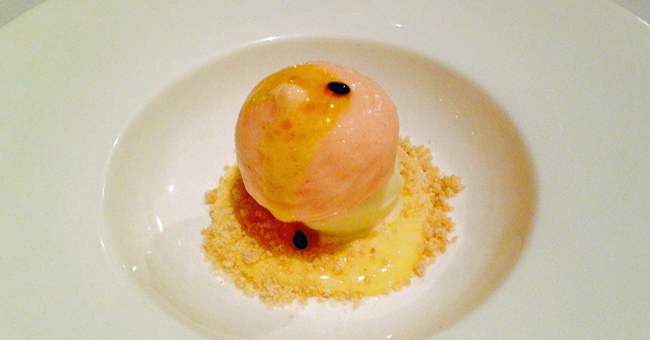
A delicate, thin tube of dark chocolate encasing a luscious banana mousse was dressed with salted caramel and paired with a fragrant almond ice cream. These balanced flavour combinations and the beautifully restrained presentation were a triumph of dessert cookery.
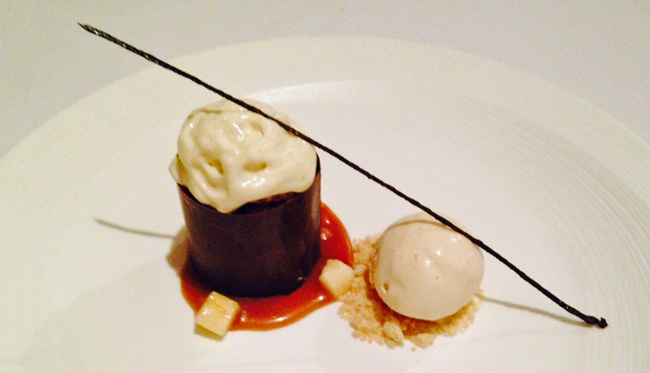
Equally accomplished was the cherry and pistachio delice, dressed with a pistachio coulis, fresh pistachios and an intense Morello cherry sorbet. Again, the flavours and textures worked in harmony with one another. (Wine: Brown Brothers Late Harvest, Orange Muscat, Flora Victoria)
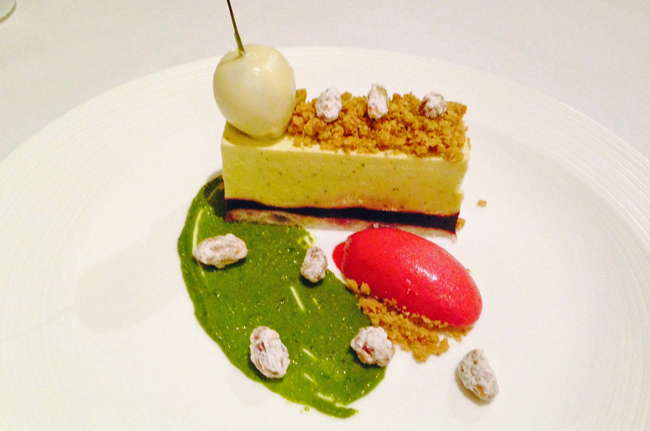
Clearly, these three desserts amply demonstrated the strengths of the pastry section. Good coffee and petit fours – jellies, truffles and fudge – completed a memorable meal, made all the more enjoyable by the knowledgeable, engaging and unobtrusive service headed by Roberto.
Phil Yeomans has clearly made a strong impression in the last year at Marwell Hotel whose owners were clearly right to place their trust in him. Although his task is unfinished, it has already helped the hotel go from strength to strength. Hampshire is not blessed with an abundance of good restaurants, so Marwell with help fill gap. Fine Dining Guide wishes him every success and will follow his progress with interest.



